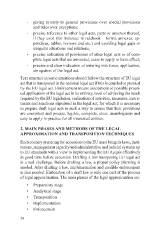Page 181 - Секретаријат за законодавство
P. 181
- giving priority to general provisions over special provisions
and rules over exceptions;
- precise reference to other legal acts, parts or annexes thereof,
if they exist (for instance: in rulebook – forms, annexes, ap-
pendices, tables, reviews and etc.) and avoiding legal gaps or
irregular situations and relations;
- precise indication of provisions of other legal acts or of com-
plete legal acts that are amended, cease to apply or have effect;
- precise and clear indication of entering into force, application,
abrogation of the legal act.
Text structure in some situations should follow the structure of EU legal
act that is transposed in the national legal act if this is entailed or pursued
by the EU legal act. Enforcement means assessment of possible practi-
cal application of the legal act in its entirety, level of achieving the result
required by the EU legislation, realisation of activities, measures, instru-
ments and sanctions stipulated in the legal act, for which it is necessary
to prepare draft legal acts in such a way to ensure that their provisions
are consistent and precise, legible, complete, clear, unambiguous and
easy to apply in practice for all interested entities.
2. MAIN PHASES AND METHODS OF THE LEGAL
APPROXIMATION AND TRANSPOSITION TECHNIQUES
Each country preparing for accession to the EU must bring its laws, insti-
tutions, management capacity and administrative and judicial systems up
to EU standards with a view to implementing the EU Acquis effectively
in good time before accession. Drafting a law transposing EU legal act
is a real challenge. Before drafting a law, a proper policy planning is
needed. After drafting a law, implementation and credible enforcement
is also needed. Elaboration of a draft law is only one part of the process
of legal approximation. The main phases of the legal approximation are:
• Preparatory stage
• Analytical stage
• Transposition
• Implementation
• Enforcement
38

